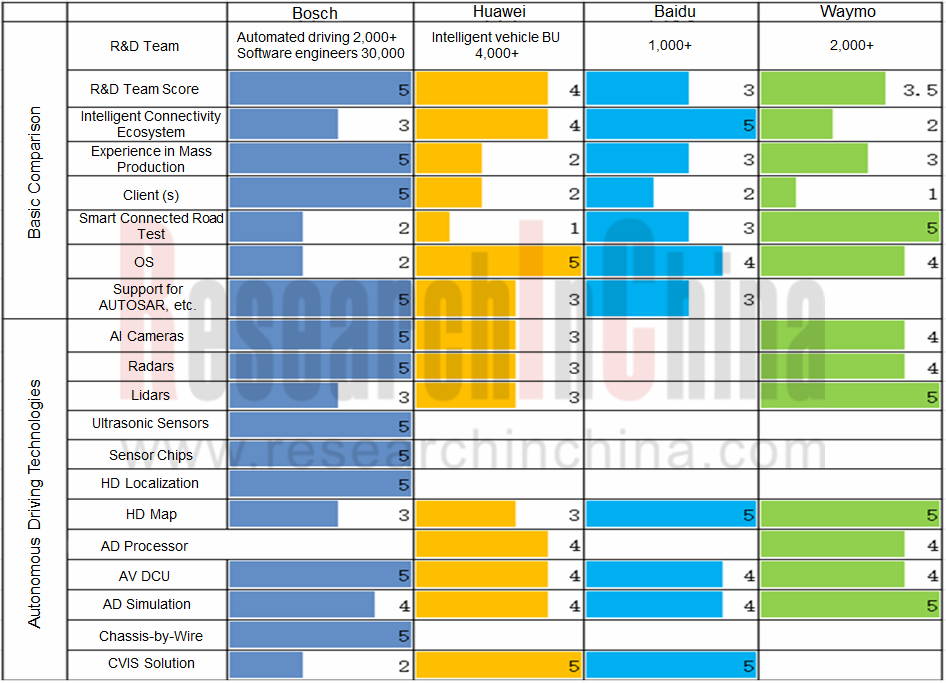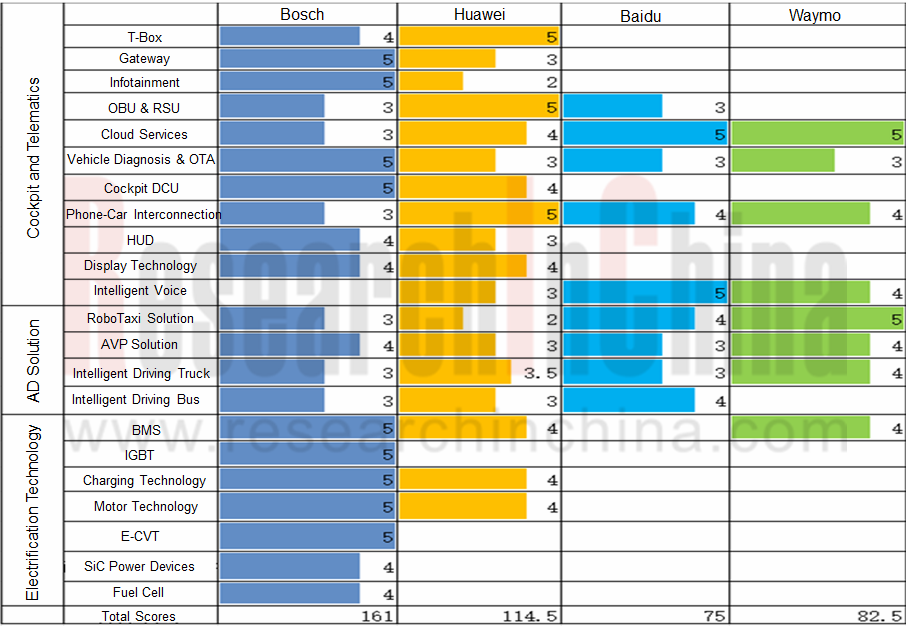Huawei CASE (Connected, Autonomous, Shared, Electrified) Layout and Strategy Research Report, 2020
Research on Huawei's CASE (Connected, Autonomous, Shared, Electrified): Who is the main rival of Huawei in automotive engagement?
Huawei showcased its automotive products at Beijing International Automotive Exhibition 2020 (Auto China 2020) held in Beijing from September 26 to October 5, 2020, where Huawei’s ambition in CASE can be clearly seen.
It is generally believed that Bosch is to be the real competitor of Huawei’s automotive involvement.
Huge gap between Huawei and Bosch in automotive business
ResearchInChina singles out 41 CASE indicators and compares them to assess such players’ CASE capabilities as Bosch, Huawei, Baidu, and Waymo.


Judging from final scores, Bosch in possession of 30,000 software engineers stays far ahead of other peers. Bosch is scheduled to lavish €4 billion into autonomous driving (AD) between 2019 and 2022, with the rising number of 2,000 AD engineers in 2019 to 4,000 ones till 2022. It is conceivable that Bosch as the leading CASE vendor will be hardly challenged within five years.
In respect of hardware, the top four emerging Chinese automakers select Bosch, and embrace BAT (Baidu, Alibaba, Tencent) as concerns software and application ecosystem.
The traditional OEMs like SAIC, Great Wall Motor, Geely and BYD have established own intelligent connectivity subsidiaries successively, attempting to develop core systems such as domain control unit (DCU), underlying layer and mid-layer software independently.
Actually, the traditional OEMs’ engagement in the development of core systems makes Tier-1 suppliers (struggling to find a new position, and most of whom are in the red with gloomy prospects) ever less viable.
The traditional automakers are desperately seeking for a transition as competition pricks up. As long as a Tier-1 supplier makes a success in a case of product use for a carmaker, there will be an inrush of orders from other automakers. For instance, Desay SV’s orders from Changan Automobile and Chery come of its multi-screen cockpit solution availability onto Leading Ideal ONE
Although with a complete product matrix, Huawei’s most products except T-Box, V2X and MDC platform have not been spawned yet. Huawei is painfully aware of a rather high threshold for access to the automotive sector, in readiness for no profits in six years.
Huawei has BAT (Baidu, Alibaba, and Tencent) as the realistic opponents
Huawei is inferior to Bosch whatever customer relationship, technical accumulation, R&D input or experience in mass production. So, Huawei is still not competent enough to threaten Bosch.
Like BAT, Huawei is just a peripheral supplier for mainstream passenger car makers, with production cooperation still in cockpit and telematics.
Goosed by vibrant players like BAT, China stays two years or three ahead of foreign countries when it comes to cockpit and Internet of Vehicle (IoV) technology application. Based on this, Huawei and BAT are turning to be the suppliers of incremental components.
As the development route of cooperative vehicle infrastructure system (CVIS) prevails in China, there is a huge Chinese market of road side perception and decision systems for intelligent transportation and smart roads. It’s just a matter of time to foray into vehicle with enough experience in roadside perception and decision since it hardly poses any threat to Bosch for the moment.
In this sense, Huawei has the realistic competitors in the recent years such as BAT and HikVision that are absorbed in cooperative vehicle infrastructure system (CVIS).
How will Huawei win out?
By referring to rivalry in the process of featured phones to smart phones, the vast majority of startups and tier-2 suppliers in the intelligent connected vehicle (ICV) field will be predictably eliminated in cut-throat competition, and only three or five of them will survive and there will be an oligarch in the intelligent vehicle computing platform market then when components will be standardized, plug and play alongside a thriving software application ecosystem.
Huawei is ambitious to be an ultimate winner, with strides in autonomous driving integrators and commercial vehicle manufacturers already.
It is with the help of Huawei MDC platform that Momenta and HoloMatic developed HWP and AVP solutions for passenger cars; that CiDi (Changsha Intelligent Driving Institute Ltd.) developed intelligent heavy truck solutions; that Neolix developed self-driving delivery system; that DeepRoute.ai developed the solution for container trucks at ports; that i-Tage Technology Co., Ltd. and WAYTOUS developed autonomous mining truck solutions.
In early 2019, Yutong Bus signed a memorandum of understanding (MOU) with Huawei about building a bus automated driving computing platform by leveraging Huawei’s MDC technologies and its automated driving technologies for buses.
In April 2019, FOTON joined forces with Huawei in developing commercial-scale intelligent driving computation platform for production models inclusive of heavy truck, medium truck, light truck, pickup, bus and van.
In May 2019, FAW Jiefang inked a deal with Huawei about joint efforts in 5G-enabled telematics, intelligent driving, rich communication suite (RCS), cloud services, among others.
In June 2019, JMC Group signed a strategic cooperation agreement with Huawei about collaborating on automotive electrification, intelligence, telematics and the technologies concerned.
In July 2020, Yutong Bus signed a contract with Huawei about joint efforts in fields like telematics platform development, intelligent driving, new energy, intelligent public transport and smart sanitation vehicle whilst pushing ahead with project implementations in a plurality of commercial vehicle scenarios.
Overall, Huawei’s automotive business route is to first encroach on the peripheral markets and then encircle the key markets. Huawei helps the ecosystem partners massively use MDC platform and impress clients with the superiority of its computing platform and ecosystem to other computing platforms, offering air support from 5G and C-V2X technologies as well as governmental demonstration projects and ‘1+8+N’ all-scenario strategy.
Huawei needs to succeed first in commercial vehicle and special vehicle fields and then acts as a full supporter for two to three Chinese passenger car makers (like BAIC Motor and BYD) from whom it makes handsome sales, with a possibility of access to the supply chain of influential passenger car makers. Only acceptance from the leading OEMs can Huawei MDC become one of the mainstream intelligent vehicle computing platforms on the Chinese market. This will take about five to eight years.
Global and China Leading Tier1 Suppliers’ Intelligent Cockpit Business Research Report, 2022 (II)
Tier1 Intelligent Cockpit Research: The mass production of innovative cockpits gathers pace, and penetration of new technologies is on a rapid riseGlobal OEMs and Tier 1 suppliers are racing for the i...
Global and China Leading Tier1 Suppliers’ Intelligent Cockpit Business Research Report, 2022 (I)
Tier1 Intelligent Cockpit Research: The mass production of innovative cockpits gathers pace, and penetration of new technologies is on a rapid riseGlobal OEMs and Tier 1 suppliers are racing for the i...
China Commercial Vehicle Intelligent Cockpit Industry Report 2021
Research on Intelligent Cockpits of Commercial Vehicles: Heading for Large Screens, Voice Interaction, Entertainment and Life
Following AD/ADAS functions, the intelligent configuration of the cockpit...
Automotive Ultra Wide Band (UWB) Industry Report, 2022
UWB got initially utilized in the military field, and began to be commercially applied after the release of criteria for UWB commercialization in 2002. In 2019, Car Connectivity Consortium (CCC) liste...
China Automotive Distribution and Aftermarket Industry Report, 2022-2027
Since the introduction of 4S store model into China at the end of 20th century, China's authorized dealer system has gradually developed from a single-store-based mode to a group-based mode, and from ...
Global and China Skateboard Chassis Industry Report, 2021-2022
Research into skateboard chassis: where to sell, how to sell and to whom it is sold
Rivian, a new carmaker based on skateboard chassis, is quite popular in the market and becomes the focus of the aut...
Emerging Automakers Strategy Research Report, 2022--NIO
Research on emerging carmaking strategies: no new cars in 2021, 3 new cars in 2022, can NIO make its renaissance?
The delivery of ET7 is imminent, and the sluggish sales situation is expected to fade...
Automotive and 5G Industry Integration Development Report, 2022
Research on integration of vehicle and 5G: OEMs rush into mass production of 5G models whose sales may reach 3.68 million units in 2025
By the end of 2021, China had built and opened in excess of 1.3...
China Automotive Finance Industry Report, 2022-2030
Auto finance is lucrative with the highest profit margin in the international automobile industry chain, contributing to roughly 23% of the global automobile industry profits. Yet, auto finance only h...
Global and China Power Battery Management System (BMS) Industry Report, 2022-2026
1. Robust demand from new energy vehicle spurs BMS market to boom
New energy vehicle sales have been growing rapidly worldwide over the recent years, reaching 6.5 million units with a year-on-year up...
ADAS/AD Chip Industry Research Report, 2022
Autonomous driving chip research: In addition to computing power, core IP, software stacks, AI training platforms, etc. are becoming more and more importantL2.5 and L2.9 have achieved mass production ...
Automotive Sensor Chip Industry Research Report, 2022
Sensor Chip Research: Automotive Sensors Have Entered a Technology Iteration Cycle, and Opportunities for Localization of Chips Are Coming Automotive sensor chips can obtain external environment ...
Automotive Cloud Service Platform Industry Report, 2021-2022
Research on Automotive Cloud Services: Based on 5ABCD, cloud services run through the R&D, production, sale, management and services of automakersWith the development of intelligent connectivity, ...
Global and China Cobalt Industry Report, 2021-2026
As a very rare metal and an important strategic resource for a country, cobalt gets typically utilized in battery materials, super heat-resistant alloys, tool steels, cemented carbides, and magnetic m...
Automotive Event Data Recorder (EDR) Industry Report, 2022
An event data recorder (EDR), sometimes referred to informally as an automotive black box, is a device or a system installed in vehicle to monitor, collect and record technical vehicle data and occupa...
Commercial Vehicle ADAS Industry Report, 2021
ResearchInChina has published the "Commercial Vehicle ADAS Industry Report, 2021", focusing on policy climate, ADAS installations, suppliers, etc., and with a deep dive into the prospects of Chinese c...
Automotive High-precision Positioning Research Report, 2022
High-precision Positioning Research: from L2+ to L3, high-precision integrated navigation and positioning will become the standard
With the development and progress of the autonomous driving industry...
China Around View System (AVS) Suppliers and Technology Trends Report, 2021 –Joint Venture Automakers
Research into JV automakers’ around view system: large-scale implementation of AVP is round the corner, and AVS vendors are energetically pushing ahead with parking fusion solution.
During January to...